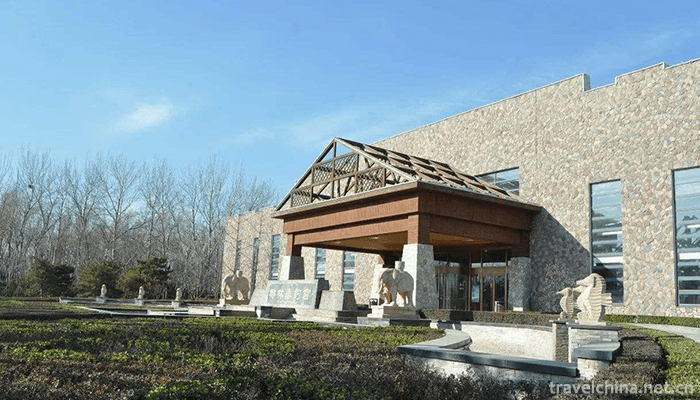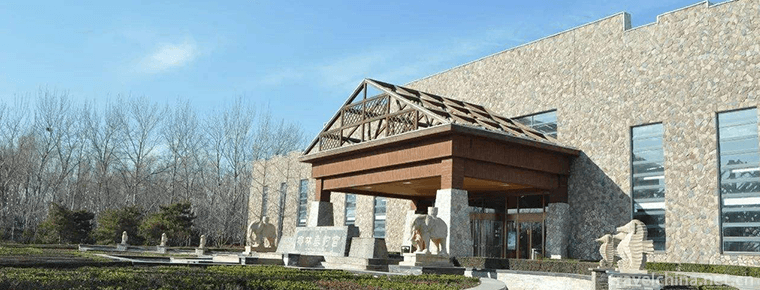Nangong Scenic Spot
Located in Wangzou Town, Fengtai District, southwestern suburb of Beijing, Nangong Village, the village where the scenic spot is located, enjoys the reputation of "China's first geothermal village". It has won eight national honorary titles, including "National Advanced Grass-roots Party Organization", "National Advanced Unit for Spiritual Civilization Creation" and "National Agricultural Tourism Demonstration Site".
Development history
Wang Zuo Town has a long history and profound cultural connotations. In 2006, the town's villages and monuments, history and culture, ancient temples, temples and folk flower fairs were extensively investigated, and many valuable historical data were obtained. In order to promote historical culture, protect cultural relics and monuments, develop cultural industry and integrate tourism resources, Wangzuo Town plans to set up a historical and cultural exhibition room in Wangzuo Town, a district-level cultural relics protection unit in the town area, the Nangong Guandi Temple.
Geographical resources
Relying on high-quality and abundant geothermal resources, the scenic spot integrates modern agricultural sightseeing, hot spring fitness, geothermal popular science education, leisure and recreational vacation. With its excellent air index, beautiful natural environment and good geographical location, it has become one of the ten tourism routes in Beijing. Nangong Tourist Scenic Area, with its magnificent humanistic landscape, beautiful natural landscape, harmonious ecological environment and garden-style tourism city, shows the modern style of the new socialist rural community to the world.
The people of Nangong wholeheartedly welcome all walks of life, party and government organs, enterprises, institutions and school groups to visit and inspect Nangong. Local culture
Culture is the soul of a city. A city without cultural connotations can not become a modern civilized city in the true sense; a city without cultural individuality can not become an admirable city of charm.
Wang Zuo Town is building an "international, garden-style tourism small city". In order to realize ecology, leisure, livability and harmony, it is not enough to develop economically, but also to inherit, disseminate and develop culture. The construction of the historical and cultural exhibition room in Wangzoo Town aims at displaying the colorful cultural relics of Wangzoo Town and striving to reflect the flavor of Wang Zou, culture, folklore and history. To satisfy the cultural aspirations of outsiders and nourish the pride and confidence of the local people. To build the exhibition room, we should not only embody the harmony and unity between man and nature, but also carry forward Wang Zuo's history and culture, integrate tourism resources and play an important role in the development of tourism in the whole town. It will not only become another highlight of Hexi Eco-zone, enrich the industrial chain of tourist areas, enhance regional visibility, but also inherit and carry forward the traditional excellent culture of the Chinese nation.
Tourism information
Ticket information
Tickets are free. There is no first gate ticket in the tourist area. Hot springs, Qianlingshan scenic spot and Qinglong Lake are sold separately.
Traffic information
Driving routes: 1. After turning right at the exit of the 19A Wangzoonang Palace on the Beijing-Hong Kong-Macao Expressway, it will arrive 1.5 kilometers along the road sign. 2. Drive westward along Lianshi Road, up to West Sixth Ring Road and towards Fengtai. See "Shayang Road" at Exit 43, then drive out to Qianlingshan Scenic Spot. See "Changqing Road" at Exit 42, then drive out to Nangong Scenic Spot and Qinglonghu Park.
Passenger routes: 321, 339, 662, 983, 458, 459, 550, 356, 978, 917 Qinglonghu special line
Ruins culture
(1) Culture
Folk flower fairs: National intangible cultural heritage - Weicun Taiping Drum, Beijing intangible cultural heritage - Miliangtun Stilts Club, etc.
Buddhist culture: Qianlingshan Grottoes and Temples, etc.
Taoist culture: Nangong Guandi Temple, etc.
(2) Monuments:
District-level cultural relics protection units: Miyan Pagoda, Qianlingshan, Nangangwa Ancient Bridge (city, District level), Sansheng Temple
Other monuments: Linjiafen Tomb, Zhoujiapo Ancient Military Village, Fomengou Ancient Quarry
(3) Cultural relics:
Regional Cultural Relics Protection: "Five Provisions of Stone Carvings"
Other cultural relics:
Arc back knife coin;
Copper cattle, golden iron pedals, several jade books, copper, iron, pottery, porcelain, stone ware, gold foil flower unearthed from Shi Siming's tomb.
Blue Dragon, Gate Ring and Stone Buddha. Existing in Beijing Liaojin Chengyuan Museum;
Dading copper coin unearthed from Wayao village is 3 square meters, and there are also Yingqing anti-porcelain Guanyin, copper lampstand, copper pot, copper tripod, Yingqing plus color lotus leaf cover pot, chrysanthemum petal body of Longquan kiln.
A celadon pot with a height of 28.4 cm was unearthed from the Ugurun family cemetery in Miliangtun Village.
Unicorn unearthed in Liu Taizhuang;
Qianlingshan Grottoes Temple unearthed a large number of stone Buddhas, ancient construction, stone tablets, Sutra boards and so on.


-
1.MountHuaguoshan
Mount Huaguoshan (Lianyungang Huaguoshan Scenic Area) is located at the middle foot of Nanyuntai Mountain in Lianyungang City.
Time 2018-12-06 -
2.West Lake Scenic Spot in Hangzhou
Hangzhou West Lake Scenic Spot is located in the center of Hangzhou City, Zhejiang Province. It is divided into lakeside area, Lake Center area
Time 2018-12-07 -
3.Huanghelou Park Wuhan
Wuhan Yellow Crane Tower Park: The Yellow Crane Tower on Snake Mountain in Wuchang is one of the three famous buildings in the south of the Yangtze River.
Time 2018-12-12 -
4.Wulong Karst Tourist Area Movie Transformers Place
Wulong Karst Tourist Area is located in Wulong District of Chongqing City. It has rare natural karst landscape, including karst caves, Tiankeng, ground crevices, canyons, peaks, alpine grasslands, etc
Time 2018-12-12 -
5.Nanzhao Custom Island Dali
Nanzhao Custom Island in Dali is one of the three islands in Erhai Lake, located in Shuanglang Township at the southeast end of Eryuan County, the golden section of Cang Er National Scenic Area
Time 2019-01-06 -
6.Floral water bay hot spring resort
Huashuiwan Hot Spring Resort is located at the foot of Xiling Snow Mountain in Dayi County, Chengdu, Sichuan Province, surrounded by mountains on all sides. National AAAA scenic spot.
Time 2019-01-17 -
7.Riddle
Riddles mainly refer to hidden words, such as allusions or words, which can be guessed by others. They can also be extended to things containing mysteries. Riddles originated from ancient Chinese folk
Time 2019-06-04 -
8.Xi an Drums Music
Xi'an drum music, also known as Chang'an ancient music. It is a large-scale traditional folk drum music spread in Xi'an (ancient Chang'an) and its surrounding areas for thousands of years. It originat
Time 2019-06-30 -
9.Xingyiquan
Xingyiquan, also known as Xingyiquan, is one of the traditional Chinese boxing. Although there are different opinions on its origin, Ji Jike (1602-1680), a native of Puzhou, Shanxi Province, was widel
Time 2019-07-08 -
10.Zuoquan Xiaohua Opera
Zuoquan Xiaohua Opera is a kind of Han folk song and dance drama which originated in Zuoquan County of Shanxi Province and spread in Yushe and Heshun areas near Zuoquan County. Its style is: one step
Time 2019-08-16 -
11.Cai Ze
Cai ze The birth and death are unknown. The Warring States Yan Guo Gang Cheng (today) Hebei All men are good at argument, wisdom, and lobbying. Cai Ze was in a desperate position to enter the Qin Dyna
Time 2019-09-14 -
12.Yibin white tower
Baita (also known as Dongyan pagoda) is located in Baita Mountain Scenic Area of Yibin Lingang Economic and Technological Development Zone. It was built in 1569, the third year of emperor muzong's reign in the Ming Dynasty.
Time 2020-10-16